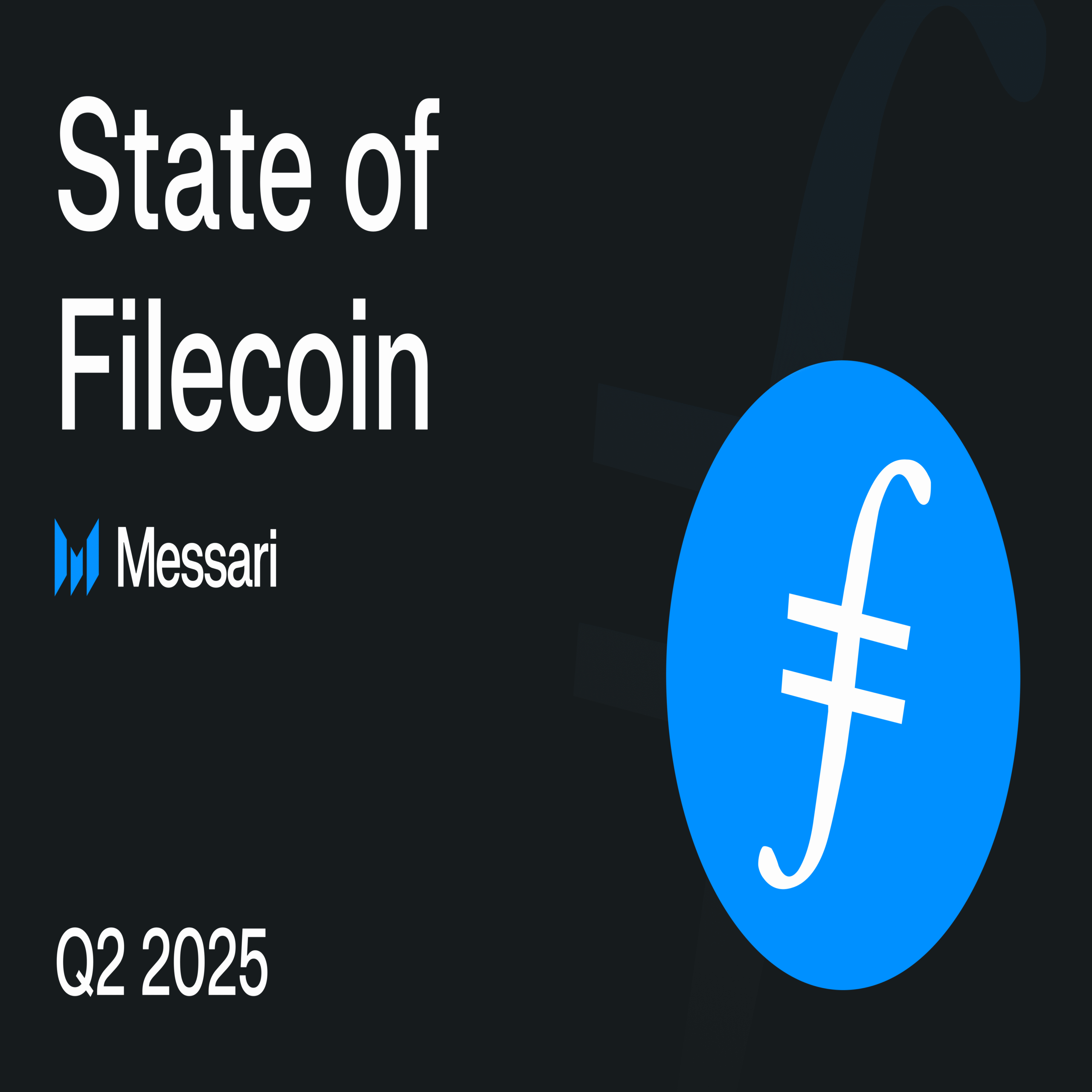Key Insights
- Network utilization increased to 32% QoQ as capacity fell 13% from provider churn and expiring allocations.
- Onboarded datasets grew 3% QoQ, with 864 exceeding 1,000 TiB in size, and daily new storage deals rose 25% QoQ, reaching 3.5 PiB per day, reflecting a sustained demand for large-scale and durable storage.
- Proof of Data Possession (PoDP) launched in May 2025, adding ongoing lightweight verification of stored data and a hot-storage tier for high-speed availability.
- Avalanche’s cross-chain data bridge went live in Q2 2025, enabling Filecoin data availability on Avalanche chains and expanding cross-chain use cases.
Primer
Filecoin (FIL) is building a marketplace for data services, with the first service being storage on top of the InterPlanetary File System (IPFS). Filecoin uses a market-driven model where users negotiate storage deals with providers at variable pricing. A storage deal acts like a service agreement, where users pay providers to store data for a specified duration.
Filecoin uses an incentive model based on cryptographic proofs, Proof of Replication (PoRep) and Proof of Spacetime (PoSt), to verify that storage providers reliably store client data over time. Providers are rewarded with FIL, the network’s native token, for participating in storage deals. Storage providers are slashed if they fail to provide reliable uptime or act maliciously against the network.
To retrieve data, Filecoin users pay a retrieval provider to fetch data. Unlike storage deals, which involve transactions onchain, retrieval deals use payment channels to settle payments offchain, to enable faster retrieval. Besides storage and retrieval, Filecoin aims to offer an open market where compute power can be contracted to run over data, providing more efficient alternatives to traditional centralized systems. Key protocol upgrades to enable compute-over-data services include smart contracts (Filecoin Virtual Machine – FVM) and scaling (Interplanetary Consensus – IPC).
Key Metrics
Performance Analysis
Network Overview
Filecoin is primarily used to decentrally store data through two parties:
- The demand side, i.e., storage users needing data storage.
- The supply side, i.e., storage providers with excess storage capacity.
The amount of data stored in active storage deals between users and storage providers gauges the demand for Filecoin storage.
Storage Deals
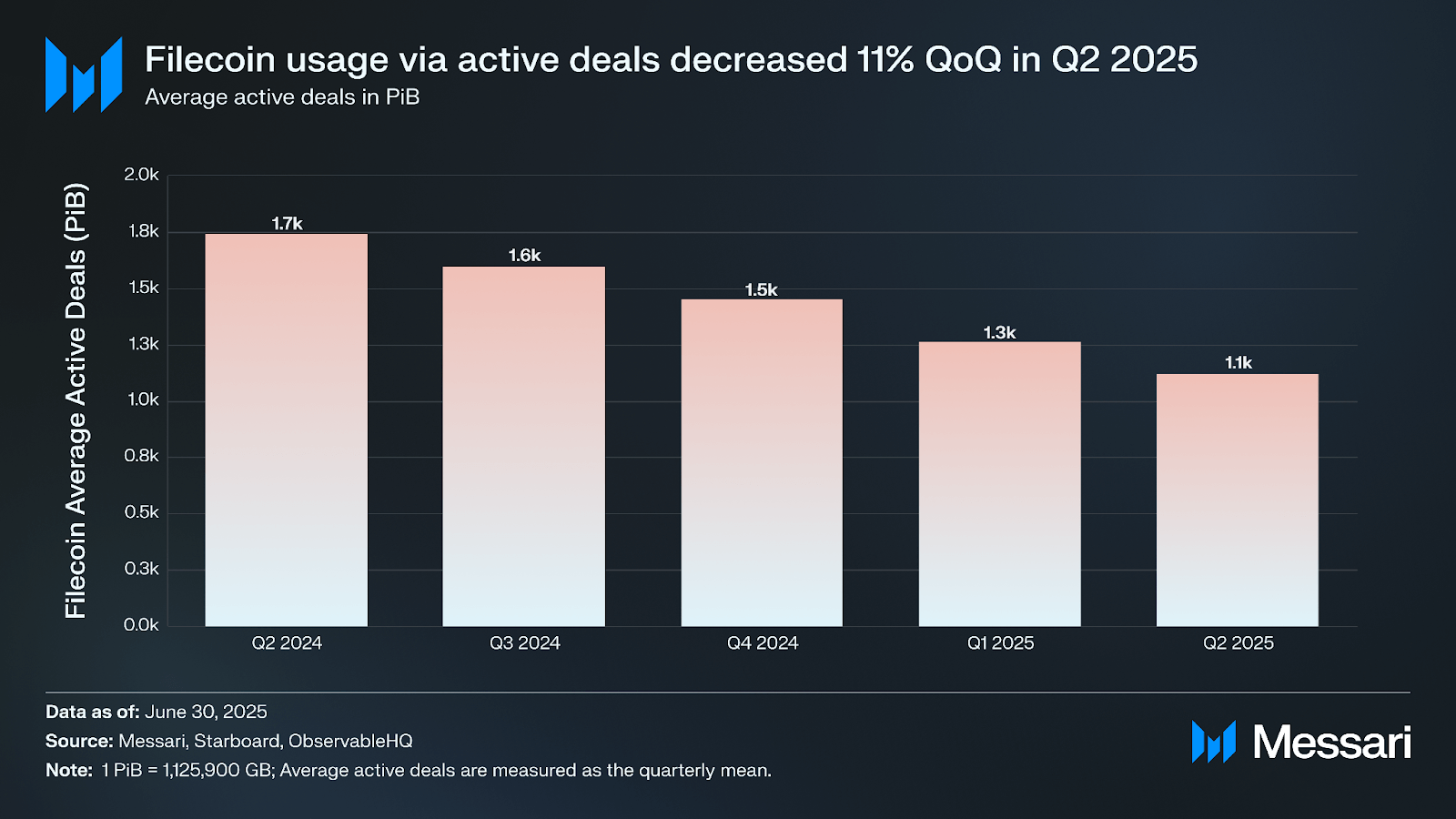
In Q2 2025, total data stored through active storage deals on Filecoin reached 1,100 PiB, down 11% QoQ from 1,300 PiB in Q1. The number of active deals declined 5% QoQ, from 450 million in Q1 2025 to 430 million. This decrease reflects the network’s ongoing shift from prioritizing total storage capacity toward targeting high-value, enterprise-oriented workloads.
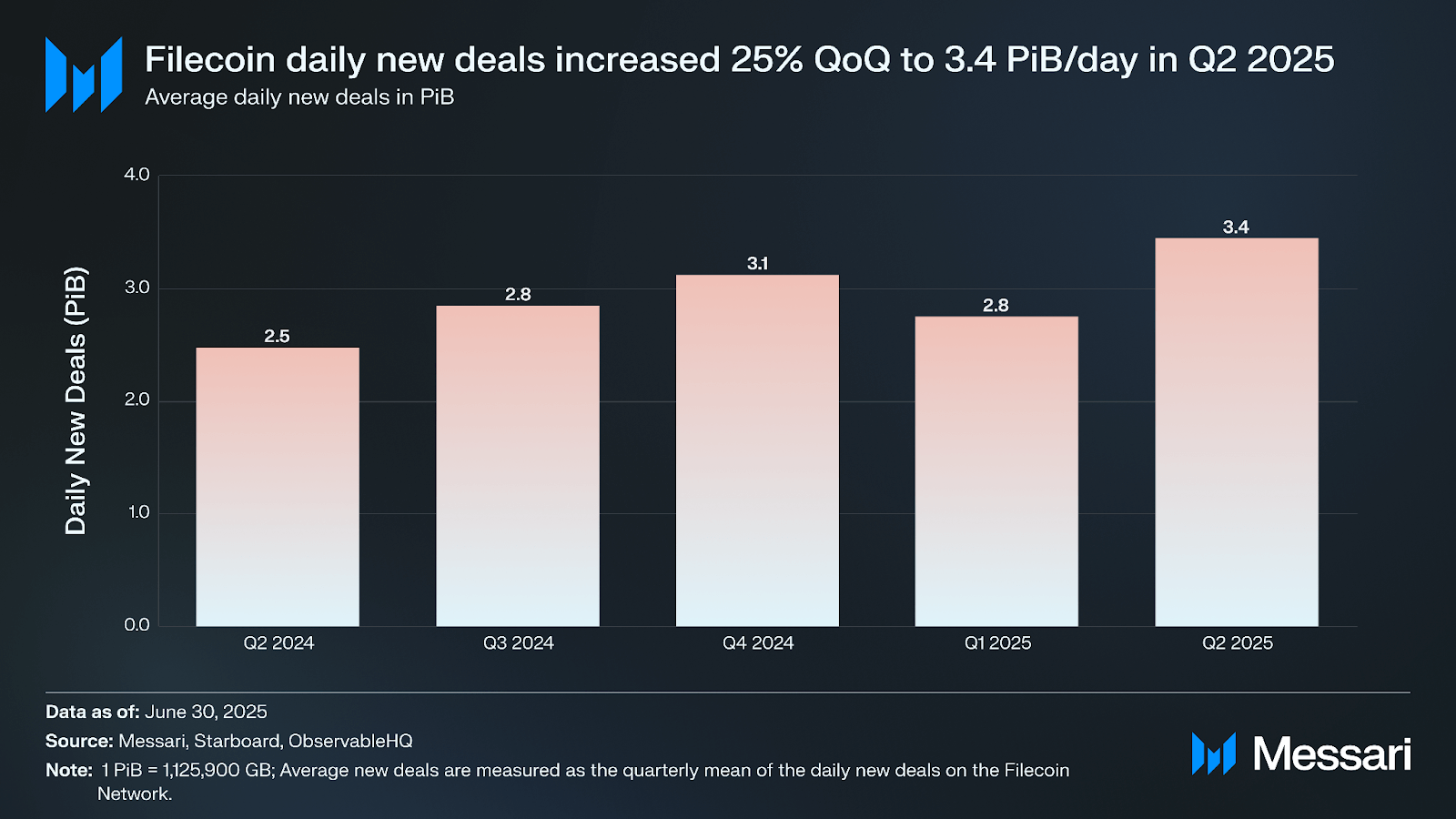
In Q2 2025, average daily new storage deals on Filecoin rose 25% QoQ, from 2.8 PiB to 3.4 PiB, while the average daily total active storage size fell 11% QoQ, from 1,300 PiB to 1,100 PiB. This divergence reflects the difference between new deal inflows and the overall active deal base as expirations of prior large contracts, particularly short-term or zero-priced onboarding deals, removed more capacity than was replaced.
Growth in new deals was likely due to Filecoin Plus onboarding activity, new on-ramp integrations that lowered entry barriers for storage providers, and increased enterprise and research workloads, including datasets from Cornell University (Ramo), The Defiant (Akave), and Humanode via Storacha. Additional demand came from AI and DePIN-related data ingestion.
The Network v25 (“Teep”) upgrade, deployed in April 2025, also contributed by improving deal efficiency, simplifying storage provider economics, and preparing for Fast Finality (F3), which will reduce settlement times and require more responsive infrastructure. Collectively, these factors drove more frequent deal initiation despite the contraction in overall active storage volumes.
Utilization vs. Capacity
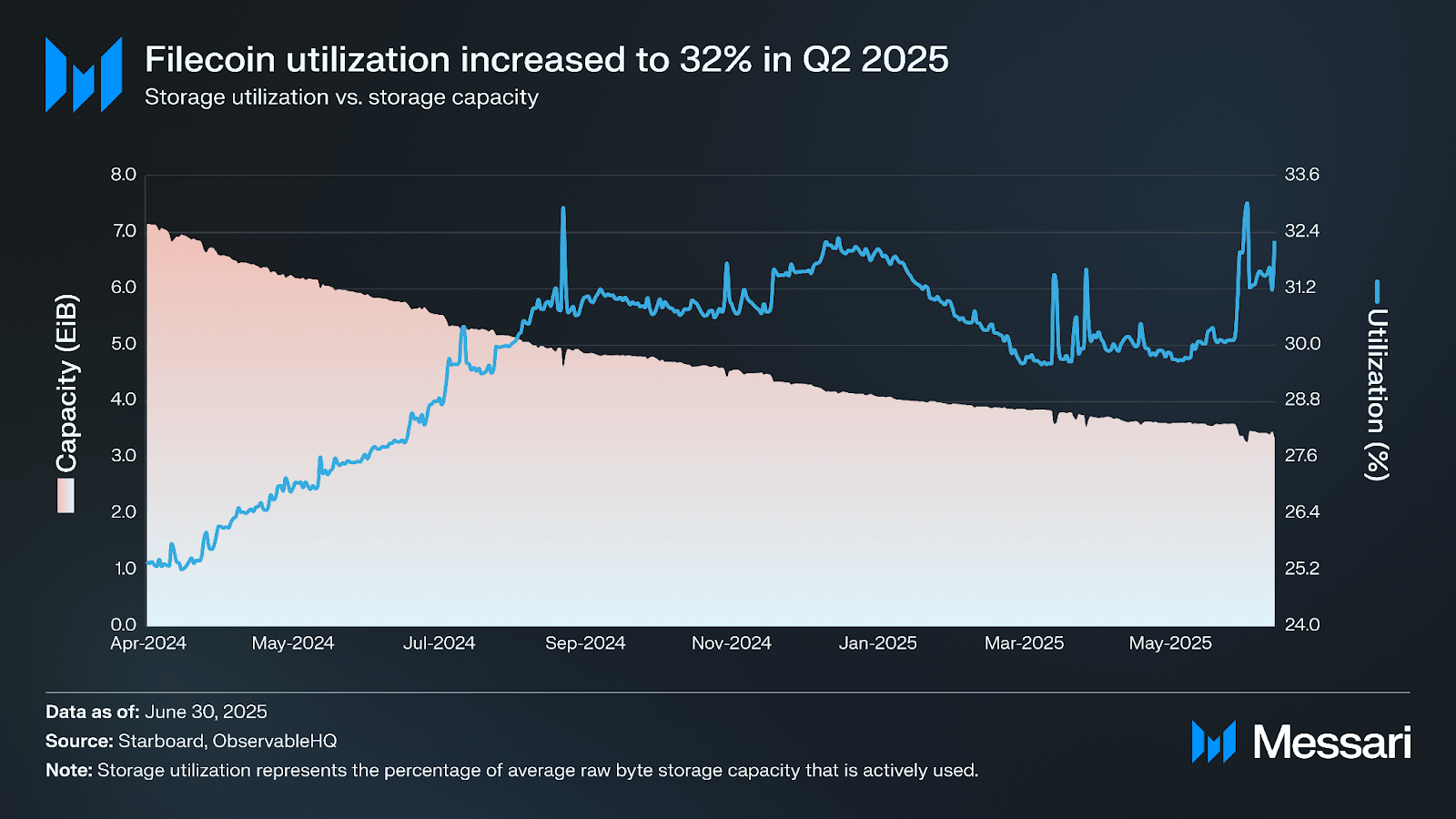
In Q2 2025, Filecoin’s storage utilization rate rose to 32%, up from 30% in Q1 2025. Total committed storage capacity declined 13% QoQ, from 3.8 Exbibytes (EiB) to 3.3 EiB. While new active deals were added during the quarter, expirations of existing contracts, particularly short-term or zero-priced onboarding agreements, reduced the overall active storage base. The lower available capacity, combined with stable demand from high-value workloads, increased the proportion of utilized capacity, resulting in a higher network utilization rate.
Clients
Filecoin is geared toward providing cold storage solutions (e.g., archival and recovery) for enterprises and developers. Low storage prices help attract traditional businesses seeking cost-effective alternatives for storing large amounts of archival data.
DeStor, a service provider on Filecoin that connects clients to storage providers, partnered with Qamcom Decentralised Data Security (DDS). The partnership includes potential data clients like YayPal, a Web3 gaming studio with over 500,000 users, and Fieldstream, an AI marketing analytics platform. Examples of other client solutions include:
- GhostDrive: Focused on prioritizing privacy and security through encryption, decentralization, and novel storage optimization techniques;
- CIDGravity: Focused on enterprise integrations with open-source platforms like Nextcloud.
Beyond cold storage, other efforts are driven by storage solutions from Lighthouse, Akave, Storacha , among others.

By the end of Q2 2025, Filecoin hosted 2,416 onboarded datasets, up 3% QoQ from 2,340 in Q1. Of these, 864 datasets exceeded 1,000 TiB in size, a 7.5% increase from 804, underscoring continued adoption for high-volume, durable storage. This growth was supported by ongoing Filecoin Plus onboarding activity, the addition of new on-ramp integrations that lowered dataset ingestion barriers, and an uptick in enterprise and research workloads.
FVM Traction
The Filecoin Virtual Machine (FVM) enables Ethereum-style smart contracts directly on top of Filecoin’s storage layer, allowing developers to build applications that automate data onboarding, pricing, retrieval, and compute coordination.

In Q2 2025, Filecoin recorded $67 million in total inflows (net deposits), down 23% from $88 million in Q1 2025. Total outflows and borrows fell 36% from $68 million to $43 million over the same period.
When measured in FIL, token activity moved in the opposite direction. Inflows rose 11% QoQ from 23 million FIL to 25 million FIL, while outflows declined 6% QoQ from 18 million FIL to 17 million FIL. This growth in FIL-denominated activity occurred despite a 44% drop in FIL’s price during the quarter (from $3.20 to $2.78), which reduced the USD-equivalent volumes.
The increase in token-based activity was likely supported by Q2 developments such as the implementation of FIP-81, which raised collateral requirements for storage providers and locked more FIL in the network; the initial effects of FIP-100, which burns a portion of protocol revenue in FIL; and enterprise onboarding incentives structured directly in FIL. Together, these factors sustained onchain token flows despite lower market prices and declining USD volumes.
Financial Overview
Filecoin’s revenue model shares similarities with Ethereum due to its EIP-1559-inspired gas system, where some network fees are burned to regulate congestion. However, unlike Ethereum, Filecoin’s economy is storage-driven, with storage users paying fees and storage providers earning revenue while managing collateral and penalties.
Network Fees
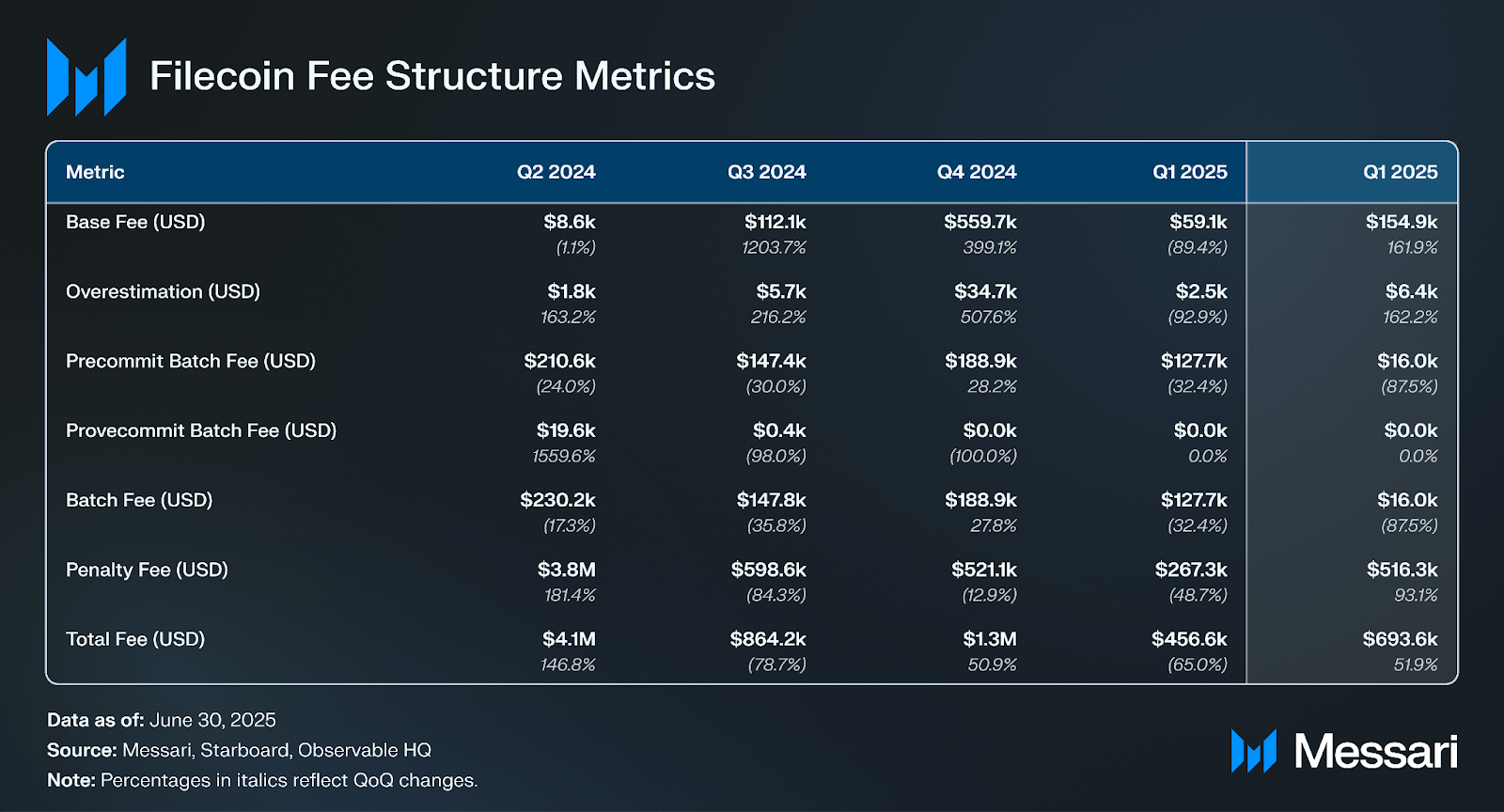
As per Messari’s revenue analysis, Filecoin’s fees comprise of:
- Base Fees: Determined by blockspace congestion and required by any storage proof.
- Batch Fees: Used for bundling storage proofs to optimize costs.
- Overestimation Fees: Required to optimize gas usage.
- Penalty Fees: Collected for storage provider failures.
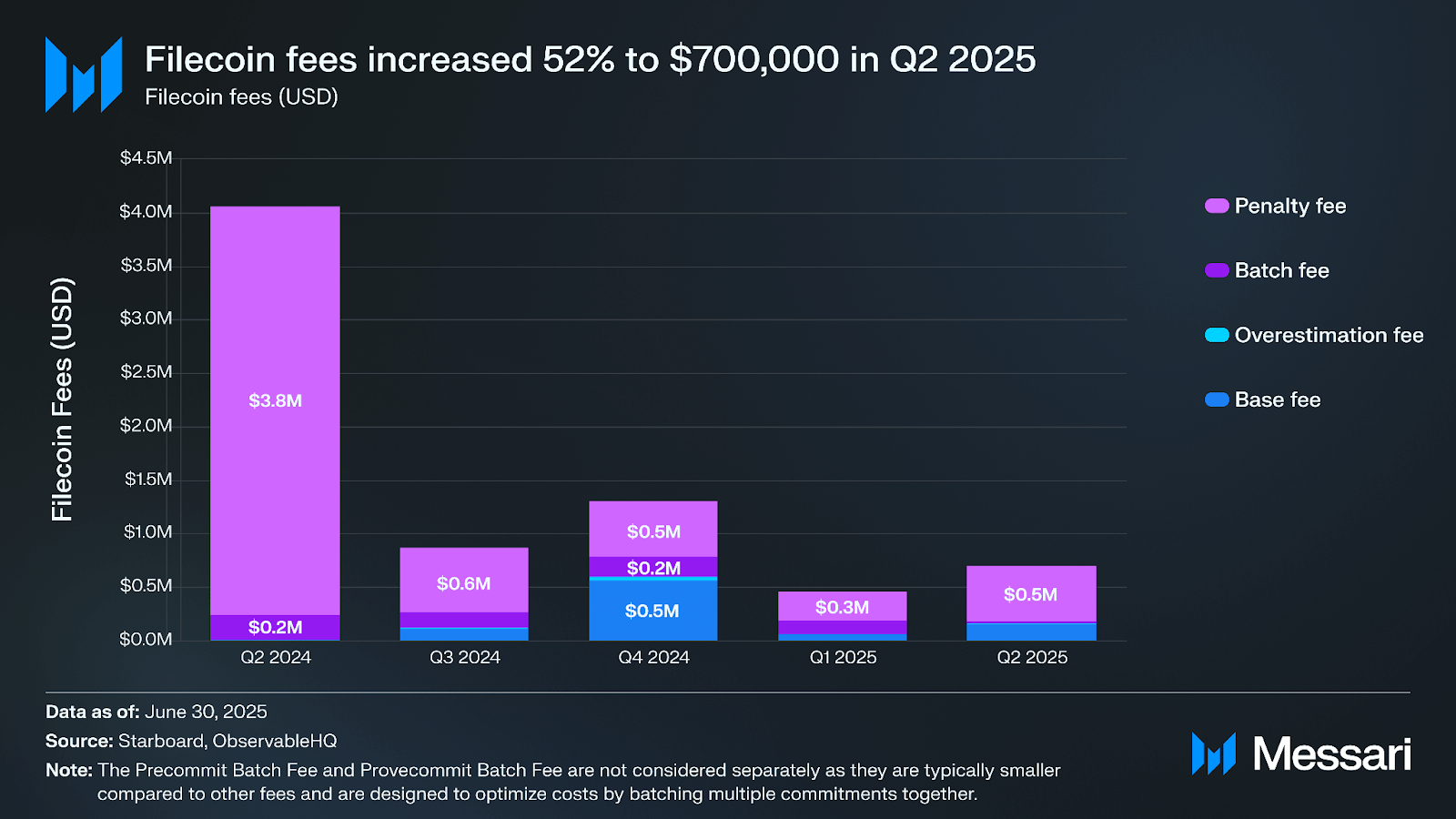
- Base Fees: rose 162% QoQ to $155,000, reflecting higher onchain transaction activity and greater network utilization despite overall lower storage capacity.
- Batch Fees: fell 88% QoQ to $16,000, reflecting reduced onboarding of large numbers of sectors in single transactions, consistent with the decline in total active storage volume.
- Overestimation Fees: (penalties for overestimating gas) also increased 162% QoQ to $6,400, likely tied to fluctuating gas price conditions and higher developer or provider activity.
- Penalty Fees: increased 93% QoQ to $520,000, accounting for approximately 74% of total network fees. This indicates increased slashing events, possibly linked to deal expirations, reduced capacity, or provider non-compliance under tightened participation requirements.
The fee profile for Q2 2025 points to a network in transition. While base fee growth reflects more frequent onchain activity, likely tied to new deal initiations, smart contract usage on the FVM, and Filecoin Plus onboarding, the sharp drop in batch fees aligns with the shift away from high-volume, short-term, or zero-priced onboarding toward fewer but higher-value deals.
The spike in penalty fees suggests operational challenges for some storage providers amid stricter performance standards post-Network v25, which may have contributed to capacity declines but also raised the proportion of fees coming from enforcement rather than new storage expansion.
Market Cap
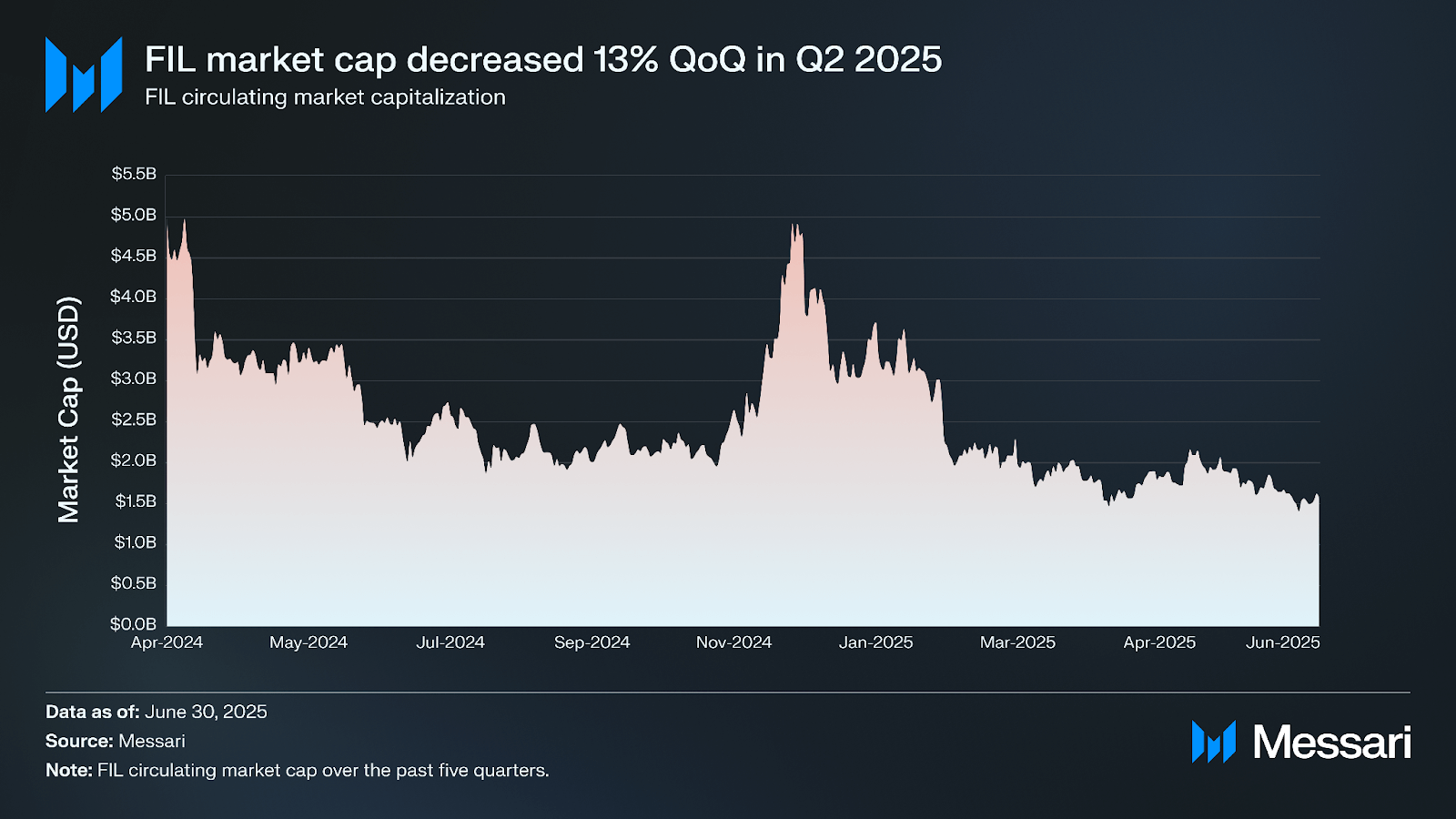
In Q2 2025, FIL’s circulating market cap (USD) declined 13.1% QoQ to $1.6 billion, down from $1.8 billion in Q1 2025. The decrease was driven by a 17% QoQ drop in FIL’s token price, which fell from $2.78 to $2.30, while circulating supply grew 4.9% QoQ to 677.7 million FIL, consistent with previous issuance rates.
DeFi Ecosystem
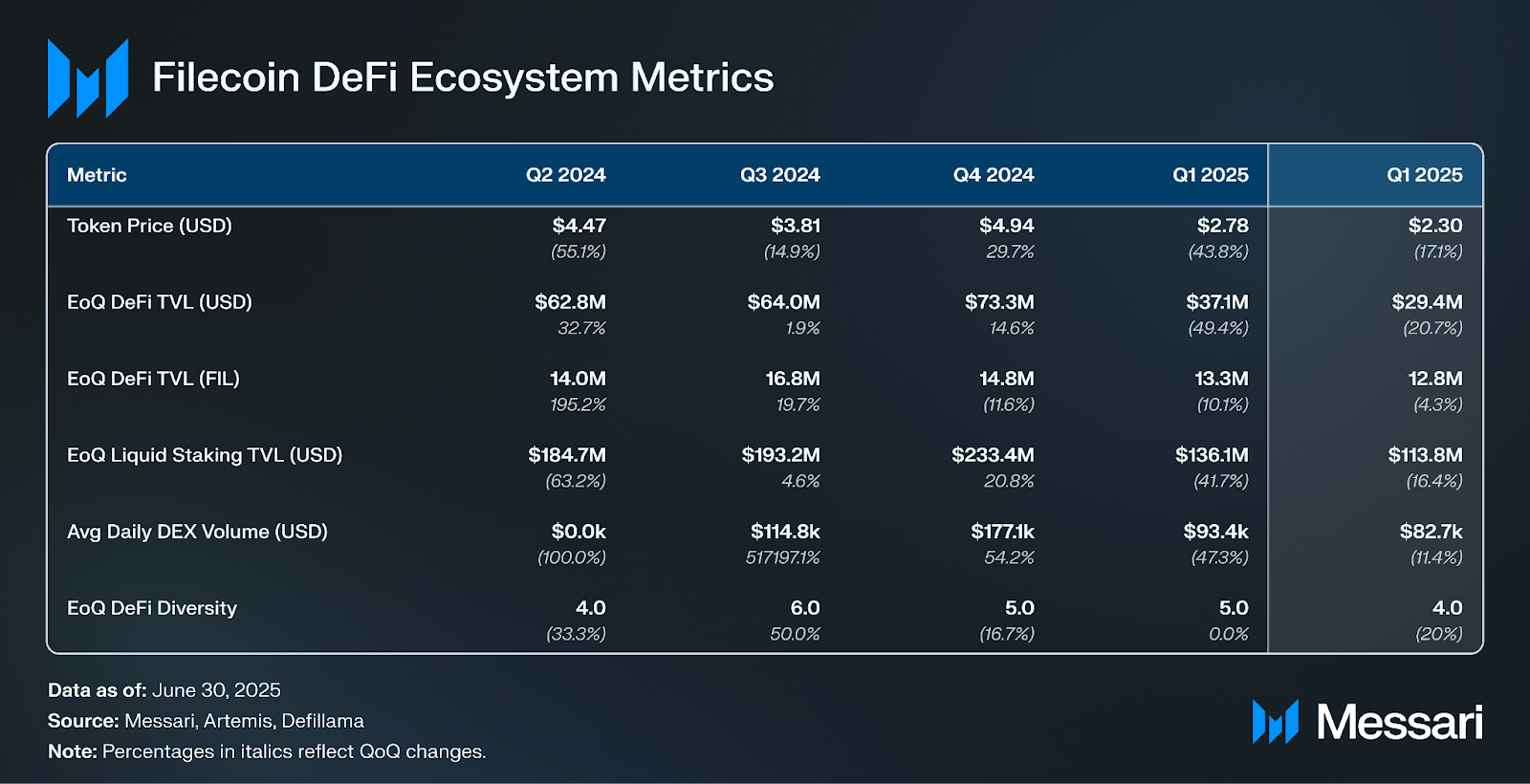
In Q2 2025, total FIL staked continued a steady decline, falling 6.2% QoQ to 127.6 million from from 155.1 million FIL in Q2 2024. In USD terms, staked value dropped 22.3% to $293.8 million, driven by both the reduction in staked tokens and a 17.1% price decrease during the quarter.
The eligible supply staked ratio fell to 17%, down from 19% in Q1 2025, despite annualized nominal yields rising sharply from 21% to 52%. The increase in yield was largely a function of reduced staking participation, which concentrated rewards among fewer participants.
TVL Trends
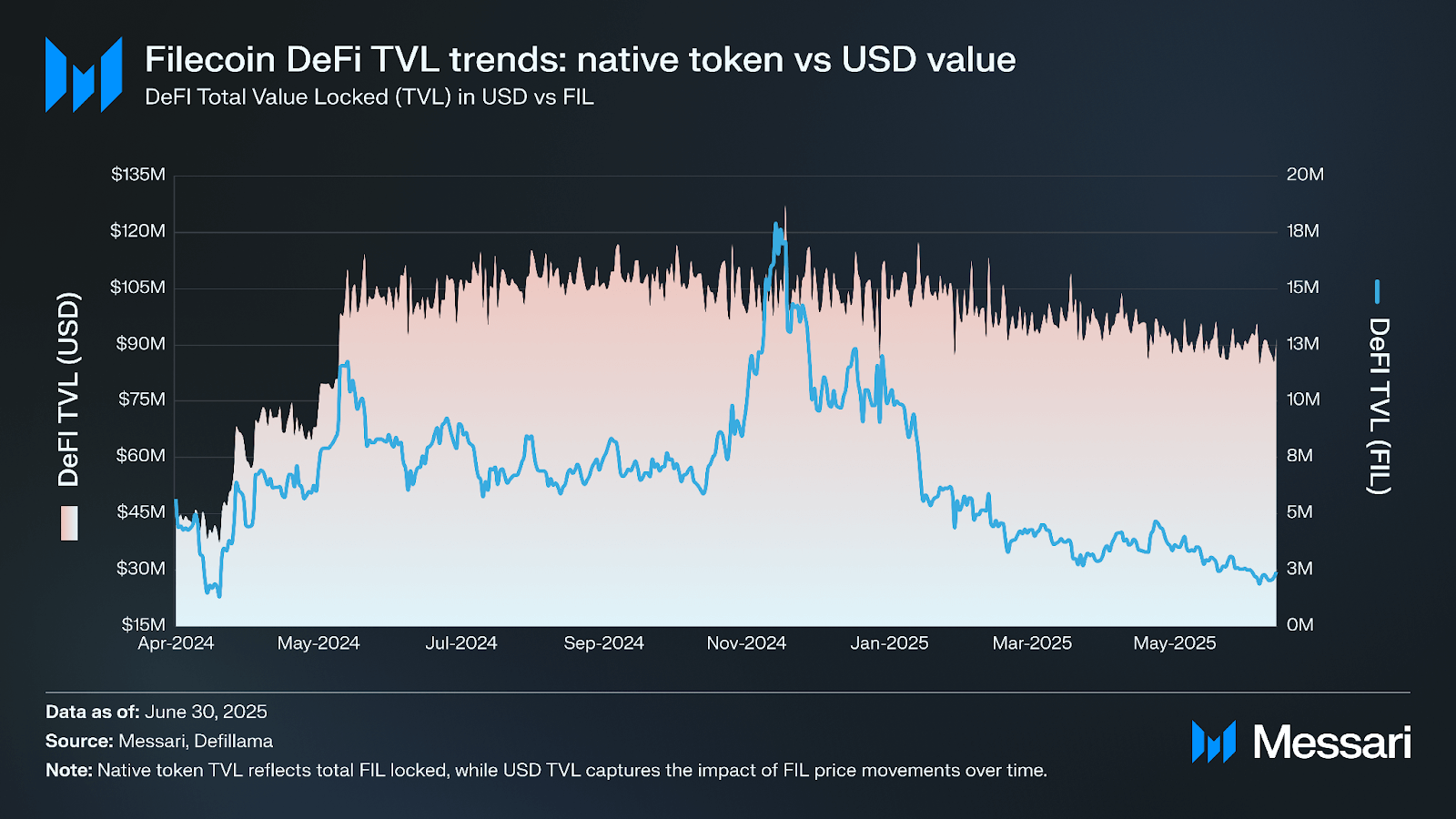
Liquid staking TVL followed a similar pattern, decreasing 16.4% QoQ to $113.8 million while falling 0.6 million when denominated in FIL, suggesting modest withdrawals in addition to price impact. Average daily DEX volumes dropped 11.4% QoQ to $82.7k, marking a second consecutive quarter of reduced onchain trading activity. Filecoin’s DeFi diversity score (i.e., the number of protocols making up 90% of a network’s TVL)fell from five protocols to four, indicating a contraction in the network’s concentration of DeFi activity.
The decline across USD-denominated DeFi metrics was primarily a result of FIL’s 17.1% QoQ price drop combined with limited onchain inflows. This occurred despite ongoing growth in the FVM ecosystem, suggesting that most of the recent contract deployment activity remains in early stages without significant liquidity traction.
Stablecoins
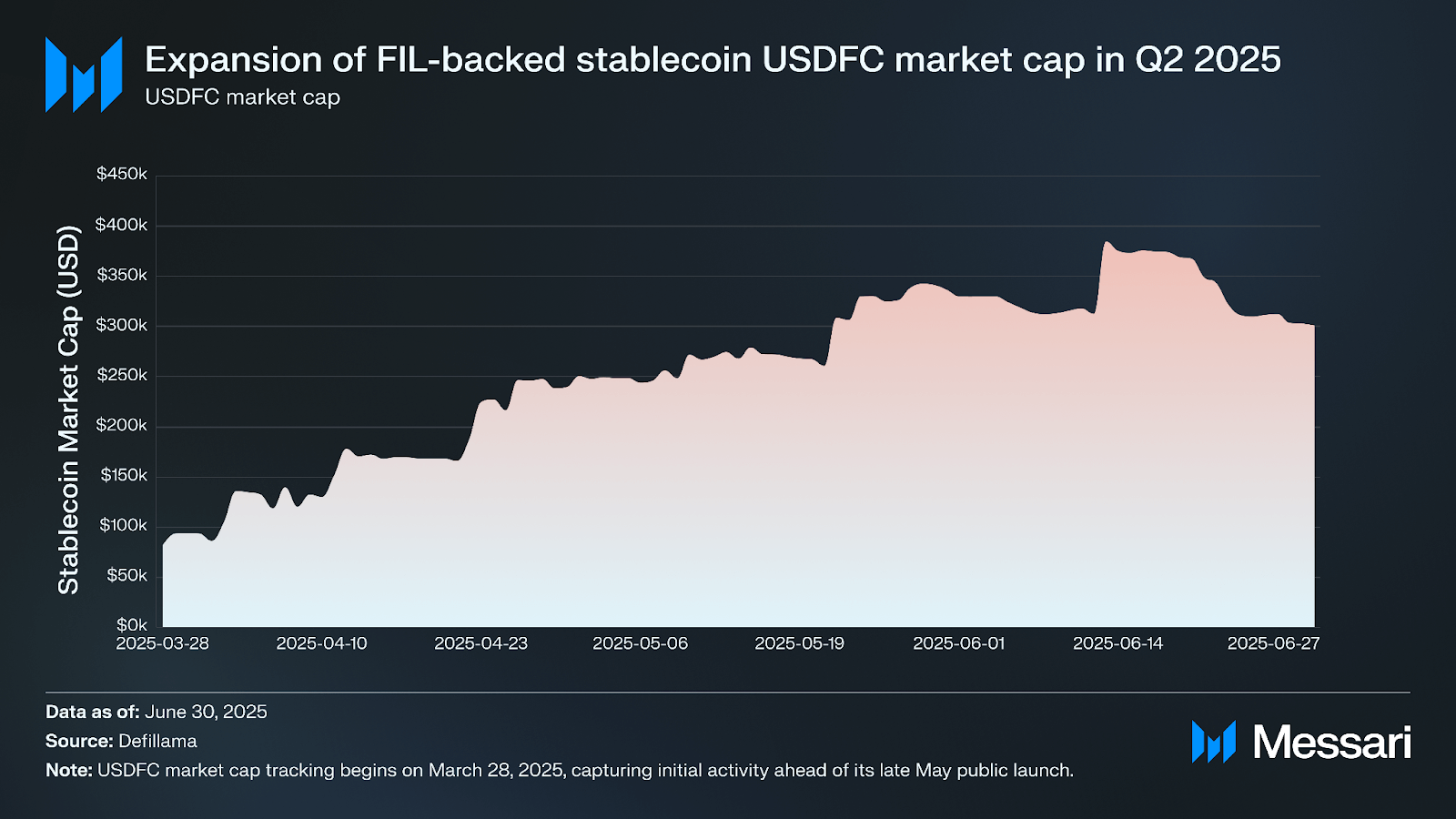
USDFC, a FIL-backed stablecoin launched by Secured Finance in early 2025, is designed to increase liquidity within the Filecoin economy by allowing FIL collateralization and reducing FIL sell pressure. It provides a native, dollar-pegged asset for trading, lending, and DeFi use without leaving the network.
In Q2 2025, USDFC’s market cap rose from $93,000 at the end of March to a mid-June peak of over $384,000 before closing the quarter at $301,000. The growth reflects slow growth in Filecoin-native lending and trading, alongside greater willingness from storage providers and DeFi participants to hold value in a FIL-collateralized, dollar-pegged asset.
Long-term, USDFC’s role could strengthen as Filecoin’s tokenomics tighten. Vesting is scheduled to complete in October 2026, and protocol-level demand sinks such as higher storage provider collateral requirements under FIP-81 and FIL-denominated fee burns under FIP-100 are reducing circulating supply. In this environment, USDFC could deepen liquidity and support the foundation of Filecoin’s DeFi ecosystem.
Qualitative Analysis
Protocol Upgrades
Network v25 Upgrade (“Teep”): The Network v25 upgrade, codenamed “Teep”, was deployed on April 11, 2025. The release introduced protocol changes to improve storage provider efficiency, enhance developer functionality, and prepare the network for Fast Finality (F3).
The upgrade implemented three core Filecoin Improvement Proposals (FIPs):
- FIP-0097 added transient storage support (EIP-1153) to the Filecoin EVM, enabling temporary onchain data during a transaction to improve Solidity compatibility and support common Ethereum patterns such as reentrancy guards.
- FIP-0098 revised termination fee calculations, introducing a fixed-percentage model (8.5% of initial pledge) to replace variable fees, providing more predictable storage provider economics.
- FIP-0100 removed the batch balancer and gas constraints, replacing the prior batch mechanism with a daily per-sector fee. This simplified operations, reduced onboarding gas costs by up to 30%, and removed batch size limits.
Consensus parameter updates were also included to support the upcoming F3 activation. These changes streamlined network operations, improved developer tooling, and addressed scalability constraints ahead of reduced transaction finality times.
Filecoin Fast Finality (F3): The Fast Finality (F3) upgrade reduces transaction finality on the Filecoin network from approximately 7.5 hours (900 epochs) to minutes (2 epochs). Initially announced in Q3 2024, F3 completed passive testing in late Q4 2024 and underwent further refinements in Q1 2025 following issues in the Steady State testing phase, including inconsistent progress and bandwidth constraints.
F3 went live on April 29, 2025, alongside the Network v25 (“Teep”) upgrade. The release integrated the GossiPBFT consensus mechanism, achieving roughly a 100× reduction in finality time at launch. Key technical changes included support for the MCOPY opcode (EIP-5656) to improve Solidity contract efficiency and the addition of historical randomness retrieval for enhanced decentralized application security.
For storage providers, F3 shortens deal finalization times, enabling faster transaction settlement and more predictable Service Level Agreements (SLAs) without additional hardware requirements. It also improves node efficiency, making light clients more resource-efficient and accessible to new network participants.
Proof of Data Possession (PDP): Proof of Data Possession (PDP) launched on mainnet on May 6, 2025, following final contract optimizations, external audits, and integration testing with early adopters such as Storacha and Akave. PDP is a cryptographic verification system that periodically checks whether storage providers continue to hold client data without requiring full retrieval or decoding of the files.
PDP complements Proof of Replication (PoRep), which confirms that data was initially stored correctly, by adding an ongoing, lightweight mechanism to ensure long-term storage integrity for the duration of a deal. The launch introduced a new hot-storage tier with mutable collections, high-speed data availability, and lightweight verification. It was accompanied by the PDP SPX Program, which began onboarding and stress-testing storage providers and clients under real-world conditions throughout May and June 2025.
Ecosystem Growth and Adoption
- Layer-2 Scaling & Cross-Chain Storage: Basin, Akave, and Storacha, Layer‑2 (L2) solutions introduced in late 2024, continued to serve as promising on‑ramps for use cases like AI workloads, hot object storage, and multichain interoperability in early 2025. With the May 2025 launch of PDP, these L2s gained access to a new hot-stored data tier, enabling improved data availability without requiring full file retrieval.
- Cardano (Blockfrost): Blockfrost, a leading Cardano developer API service, integrated Filecoin as a decentralized backup layer for IPFS node clusters. This enables Cardano dApps to store application data in a verifiable, redundant, and censorship-resistant manner, improving resilience against node outages and centralized infrastructure risks.
- Avalanche Cross-Chain Data Bridge: On May 27, 2025, the Filecoin Foundation and Ava Labs launched a native FEVM-based bridge allowing Avalanche C-Chain smart contracts to archive and retrieve verifiable data on Filecoin. The integration enables Avalanche developers to offload large datasets to Filecoin while maintaining onchain proofs, combining the high throughput of Avalanche with Filecoin’s tamper-resistant storage capabilities.
- Ideal Customer Profiles (ICPs) and Demand Generation: Filecoin’s demand strategy in Q2 2025 centered on four Ideal Customer Profile (ICP) verticals: Large-Scale Web2 Archives handling multi-exabyte datasets with long retrieval tolerances; Web2 Object Storage offering S3-like services with fast access, Snowflake integration, and data locality controls; Web3 Object Storage supporting decentralized apps, NFTs, AI agents, and Data DAOs; and Web3 Chain Storage for blockchain data from networks like Solana and Cardano. Emerging growth areas included DePIN networks collecting large-scale consumer data and AI/edge computing workloads, with notable paid deals such as Cornell University’s astrophysics simulations (Ramo), The Defiant’s media archive (Akave), AI agent data storage (Recall), and identity data (Humanode via Storacha).
Developer Initiatives and Community Growth
- FIL ProPGF Launch: Launched in March 2025, the Filecoin Foundation’s FIL ProPGF is an onchain funding mechanism for public goods across the Filecoin ecosystem. While applications opened in Q1, Q2 2025 marked the program’s first funding decisions and onboarding of initial grant recipients. Supported initiatives in this round focused on tooling, research, governance, UX improvements, and customer success, reflecting the program’s goal of fostering sustainable, community-driven development.
- Filecoin AI Blueprints Hackathon: Co-organized with Encode Club, this global hackathon focused on building decentralized AI infrastructure, with an emphasis on data provenance, storage, and integrity. Held from March 17 to April 14, 2025, it concluded with 86 project submissions and $77,000 in prizes. Solutions explored verifiable AI data pipelines, decentralized compute coordination, and Filecoin-backed dataset management.
- FIL Dev Summit 6: The sixth Filecoin Developer Summit took place on May 12–13, 2025, in Toronto, following a virtual kickoff from April 23–30. The summit convened developers, storage providers, and ecosystem contributors to discuss protocol advancements in storage, retrieval, governance tooling, and new features such as PDP and F3.
- Hackathons and Developer Bounties: Q2 featured the Protocol Labs PL_Genesis: Modular Worlds hackathon, which offered over $250,000 in prizes and opportunities to the Founders’ Forge pre‑accelerator, designed to support builders across modular, composable stack development paths.
- FIL Euro Tour: A separate series of community events held across multiple European cities to strengthen regional engagement, expand ecosystem awareness, and connect local developers and storage providers.
Key Governance Developments
FilPoll V2: Following its February 2025 launch, FilPoll V2 remained the primary governance coordination tool in Q2, supporting sentiment polling, Filecoin Improvement Proposals (FIP) tracking, and community proposal reviews. In Q2, it was used to facilitate broader input on active Filecoin Improvement Proposals, including those tied to the Network v25 “Teep” upgrade and F3 activation. Minor interface refinements were introduced to improve proposal categorization and make polling results more accessible to non-technical participants. Three notable FIPs advanced during the quarter:
- FIP-0101 was accepted, removing the redundant ProveCommitAggregate method from miner actor logic to simplify code paths and reduce maintenance overhead.
- FIP-0077, which proposes adjustments to miner deposit requirements, progressed to the Last Call stage for final community feedback before potential adoption.
- FIP-0082 was accepted, enabling single-proving of multiple sector updates via Groth16 aggregation, reducing proof generation costs and improving efficiency for storage providers managing large numbers of sector updates.
FIDL Reporting Initiatives: The Filecoin Incentive Design Lab (FIDL), introduced in late Q1 2025, saw expanded use in Q2 as more clients, storage providers, and allocators adopted them to monitor retrieval performance, deal execution rates, and allocation efficiency. Q2 updates focused on refining metrics definitions, improving retrieval latency tracking, and adding export functionality for deeper analysis by ecosystem researchers.
Filecoin Plus (Fil+) Enhancements
Several updates in Q2 aimed to improve Datacap allocation efficiency and governance transparency.
- The Experimental Pathway Metaallocator (EPMA) launched as a 1 PiB sandbox to test innovative Datacap distribution models under Filecoin Incentive Design Lab (FIDL) oversight.
- Round 6 Allocator Applications opened from June 12 to July 11 with updated KYC requirements, strengthened compliance processes, smart contract–based allocation with onchain revocation, and improved auditing tools to enhance accountability in data onboarding.
Closing Summary
In Q2 2025, Filecoin’s circulating market cap fell 13% QoQ to $1.6 billion, reflecting a 17% decline in FIL’s price to $2.30, while token supply grew 4.9%. Core network activity strengthened, with daily new storage deals rising 25% to 3.5 PiB, and utilization increasing to 32% despite a 13% capacity reduction.
The network onboarded 2,416 datasets (+3% QoQ), including 864 large datasets over 1,000 TiB (+7.5%), driven by enterprise and research demand. PoDP launched on mainnet, enabling ongoing lightweight verification and a hot-storage tier, while Avalanche Subnet integration expanded cross-chain data availability. USDFC’s market cap grew from $93,000 to $301,000, signaling deeper DeFi integration.
Overall, Q2 highlighted growing on-network activity, new product rollouts, and ecosystem expansion, positioning Filecoin for further adoption and diversified use cases.
Let us know what you loved about the report, what may be missing, or share any other feedback by filling out this short form. All responses are subject to our Privacy Policy and Terms of Service.
This report was commissioned by Filecoin Foundation. All content was produced independently by the author(s) and does not necessarily reflect the opinions of Messari, Inc. or the organization that requested the report. The commissioning organization may have input on the content of the report, but Messari maintains editorial control over the final report to retain data accuracy and objectivity. Author(s) may hold cryptocurrencies named in this report. This report is meant for informational purposes only. It is not meant to serve as investment advice. You should conduct your own research and consult an independent financial, tax, or legal advisor before making any investment decisions. Past performance of any asset is not indicative of future results. Please see our Terms of Service for more information.
No part of this report may be (a) copied, photocopied, duplicated in any form by any means or (b) redistributed without the prior written consent of Messari®.
